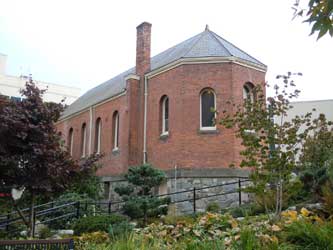This charming little brick chapel is a far cry from the imposing Christ Church Cathedral that J.C.M. Keith designed two decades earlier. Teresa Jane Despard Pemberton, widow of Joseph Despard Pemberton, bequeathed the funds for this non-denominational chapel, dedicated on Dec 29, 1909. Her artist daughter Sophie (later Mrs Deane-Drummond) designed the interior decoration.
A bridge from the modern hospital building, which wraps around it, replaces the original granite entry stair. The roof, with its original slate, is hipped, with a gable on the east end, over a modest rose window. The nave is rectangular, while the apse is semi-octagonal. Heavy timbers spring from hand-painted brackets to support the roof. The interior walls are panelled in stained and varnished wainscotting, with matching pews and furnishings; the walls above the panelling are natural brick. The windows throughout are simple diamond lights in round arched openings. The Norman-style chancel arch and the west windows are emphasized with terracotta mouldings. A choir loft at the rear now houses an organ.
The chapel remained in use until the mid-1980s when it was deemed in need of restoration and was nearly lost to a major hospital expansion plan. However it received heritage protection and it was decided that it would cost less to re-design the expansion around the chapel and the operating theatre. In 2002 the RJH School of Nursing Alumnae Association joined with VIHA and the Greater Victoria Hospital Foundation to restore both the chapel and the operating room. The chapel restoration was estimated to cost $700,000. Access to the chapel from the new Diagnostics and Treatment Centre was included in the plan as well as space for archival storage and a nursing museum in the basement. The chapel re-opened in June 2003. It is open to the public, from the hospital’s second floor.
A memorial garden, dedicated to Dr Inazo Nitobe, is in the area between the chapel and the operating room. Dr Nitobe was at one time Under-Secretary of the League of Nations. A highly esteemed ambassador for world peace, he died at the Royal Jubilee Hospital in 1933, soon after attending an international conference in Banff, AB.


Recent Comments